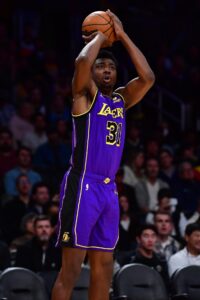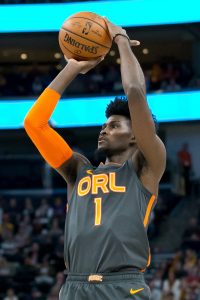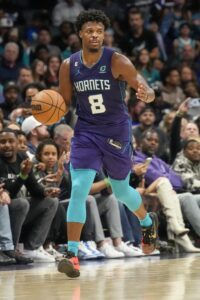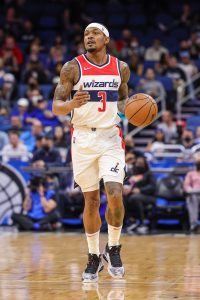As we did with 2022’s offseason trades and the in-season swaps from 2021/22, we’ll be keeping track of all the NBA trades completed this season, updating this article with each transaction. This post can be found anytime throughout the season on our desktop sidebar under “Hoops Rumors Features,” or in our mobile menu under “Features.”
Trades are listed here in reverse chronological order, with the latest on top. So, if a player has been dealt multiple times, the first team listed as having acquired him is the one that ended up with him. Trades listed in italics have been agreed upon but are not yet official. For more details on each trade, click the date above it.
For more information on the specific conditions dictating if and when draft picks involved in these deals will actually change hands, be sure to check out RealGM.com’s breakdown of the details on traded picks.
Here’s the full list of the trades completed during the 2022/23 NBA season:
- Clippers acquire Mason Plumlee.
- Hornets acquire Reggie Jackson, the Clippers’ 2028 second-round pick, and cash ($1MM).
- Knicks acquire Josh Hart, the draft rights to Bojan Dubljevic (from Trail Blazers), and the draft rights to Daniel Diez (from Trail Blazers).
- Trail Blazers acquire Matisse Thybulle, Cam Reddish, Ryan Arcidiacono, the Knicks’ 2023 first-round pick (top-14 protected), and the draft rights to Ante Tomic (from Knicks).
- Sixers acquire Jalen McDaniels, the Knicks’ 2024 second-round pick (from Hornets), and the Trail Blazers’ 2029 second-round pick.
- Hornets acquire Svi Mykhailiuk, either the Hornets’, Hawks’, or Nets’ 2023 second-round pick (whichever is most favorable; from Sixers), and either the Pelicans’ or Trail Blazers’ 2027 second-round pick (whichever is most favorable; from Trail Blazers).
- Note: The Hornets traded away their 2023 second-round pick in a prior deal.
- Clippers acquire Eric Gordon, the Raptors’ 2024 second-round pick (from Grizzlies), either the Pacers’ 2024 second-round pick or the least favorable of the Cavaliers’ and Jazz’s 2024 second-round picks (whichever is most favorable; from Grizzlies), and the Grizzlies’ 2027 second-round pick.
- Grizzlies acquire Luke Kennard and the right to swap a 2026 second-round pick (the most favorable of the Celtics’, Pacers’, and Heat’s picks) for the Clippers’ 2026 second-round pick.
- Rockets acquire Danny Green, John Wall, and the right to swap the Bucks’ 2023 first-round pick for either the Clippers’ or Thunder’s 2023 first-round pick (whichever is least favorable; top-six protected; from Clippers).
- Celtics acquire Mike Muscala.
- Thunder acquire Justin Jackson, a 2023 second-round pick (details below), and the Celtics’ 2029 second-round pick.
- Note: If the Rockets’ second-round pick lands at No. 31 or No. 32, the Thunder will receive either the Mavericks’, Heat’s, or Trail Blazers’ 2023 second-round pick (whichever is least favorable). If the Rockets’ pick lands anywhere else in the second round, the Thunder will receive either the Rockets’ or Trail Blazers’ 2023 second-round pick (whichever is least favorable).
- Pelicans acquire Josh Richardson.
- Spurs acquire Devonte’ Graham, either the Pelicans’ or Bulls’ 2024 second-round pick (whichever is most favorable), either the Pelicans’ or Trail Blazers’ 2026 second-round pick (whichever is least favorable), the Pelicans’ 2028 second-round pick, and the Pelicans’ 2029 second-round pick.
- Hawks acquire Saddiq Bey.
- Pistons acquire James Wiseman.
- Warriors acquire Gary Payton II, the Hawks’ 2026 second-round pick, and the Hawks’ 2028 second-round pick.
- Trail Blazers acquire Kevin Knox, either the Hawks’, Nets’, or Hornets’ 2023 second-round pick (whichever is second-most favorable), the Hawks’ 2024 second-round pick, the Hawks’ 2025 second-round pick (protected 41-60), the Grizzlies’ 2026 second-round pick (top-42 protected; from Warriors), and the Warriors’ 2028 second-round pick.
- Note: The Hawks previously traded their 2024 second-round pick to the Trail Blazers with top-55 protection. Those protections were removed as part of this deal.
- Suns acquire Darius Bazley.
- Thunder acquire Dario Saric, the Suns’ 2029 second-round pick, and cash ($1MM).
- Rockets acquire Justin Holiday, Frank Kaminsky, the Thunder’s 2024 second-round pick, and the Thunder’s 2025 second-round pick.
- Hawks acquire Garrison Mathews and Bruno Fernando.
- Suns acquire Kevin Durant and T.J. Warren.
- Nets acquire Mikal Bridges, Cameron Johnson, the Suns’ 2023 first-round pick (unprotected), the Suns’ 2025 first-round pick (unprotected), the Suns’ 2027 first-round pick (unprotected), the Suns’ 2029 first-round pick (unprotected), the right to swap first-round picks with the Suns in 2028, the Bucks’ 2028 second-round pick, the Bucks’ 2029 second-round pick, and the draft rights to Juan Pablo Vaulet (from Pacers).
- Bucks acquire Jae Crowder.
- Pacers acquire Jordan Nwora, George Hill, Serge Ibaka, either the Bucks’ 2023 second-round pick or the least favorable of the Cavaliers’ and Warriors’ 2023 second-round picks (whichever is most favorable), the Bucks’ 2024 second-round pick, the Pacers’ 2025 second-round pick (from Bucks), and cash ($1.36MM; from Nets).
- Note: The Bucks acquired the Pacers’ 2025 second-round pick in a prior trade.
- Clippers acquire Bones Hyland.
- Nuggets acquire Thomas Bryant.
- Lakers acquire Mohamed Bamba, Davon Reed, the Clippers’ 2024 second-round pick, and the Clippers’ 2025 second-round pick.
- Magic acquire Patrick Beverley, the Nuggets’ 2024 second-round pick, and cash ($2MM; from Lakers).
- Lakers acquire D’Angelo Russell, Malik Beasley, and Jarred Vanderbilt.
- Timberwolves acquire Mike Conley, Nickeil Alexander-Walker, either the Wizards’ or Grizzlies’ 2024 second-round pick (whichever is least favorable; from Lakers), the Jazz’s 2025 second-round pick, and the Jazz’s 2026 second-round pick.
- Jazz acquire Russell Westbrook, Damian Jones, Juan Toscano-Anderson, and the Lakers’ 2027 first-round pick (top-four protected).
- Raptors acquire Jakob Poeltl.
- Spurs acquire Khem Birch, the Raptors’ 2024 first-round pick (top-six protected), the Raptors’ 2023 second-round pick, and the Raptors’ 2025 second-round pick.
- Kings acquire Kessler Edwards and cash ($2.58MM).
- Nets acquire the draft rights to David Michineau.
- Spurs acquire Dewayne Dedmon and the Heat’s 2028 second-round pick.
- Heat acquire cash ($110K).
- Mavericks acquire Kyrie Irving and Markieff Morris.
- Nets acquire Spencer Dinwiddie, Dorian Finney-Smith, the Mavericks’ 2029 first-round pick (unprotected), the Mavericks’ 2027 second-round pick, and the Mavericks’ 2029 second-round pick.
- Lakers acquire Rui Hachimura.
- Wizards acquire Kendrick Nunn, the Bulls’ 2023 second-round pick, either the Lakers’ or Wizards’ 2028 second-round pick (whichever is least favorable), and the Lakers’ 2029 second-round pick.
- Note: The Lakers acquired the Wizards’ 2028 second-round pick in a prior trade.
- Spurs acquire Noah Vonleh and cash ($1.5MM).
- Celtics acquire the Spurs’ 2024 second-round pick (top-54 protected).
 2022/23: $47,063,478
2022/23: $47,063,478 2022/23: $2,133,278
2022/23: $2,133,278

